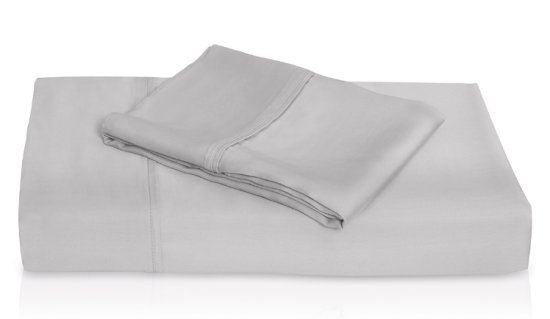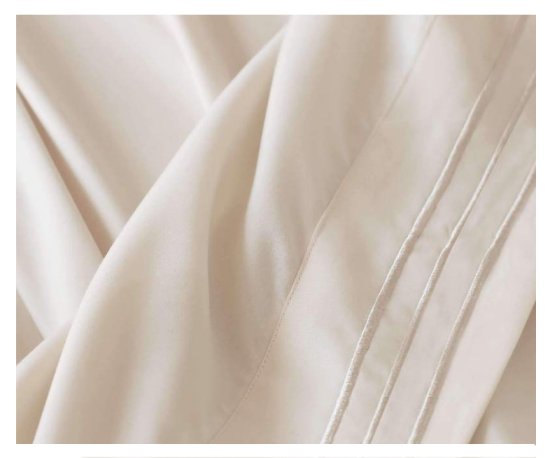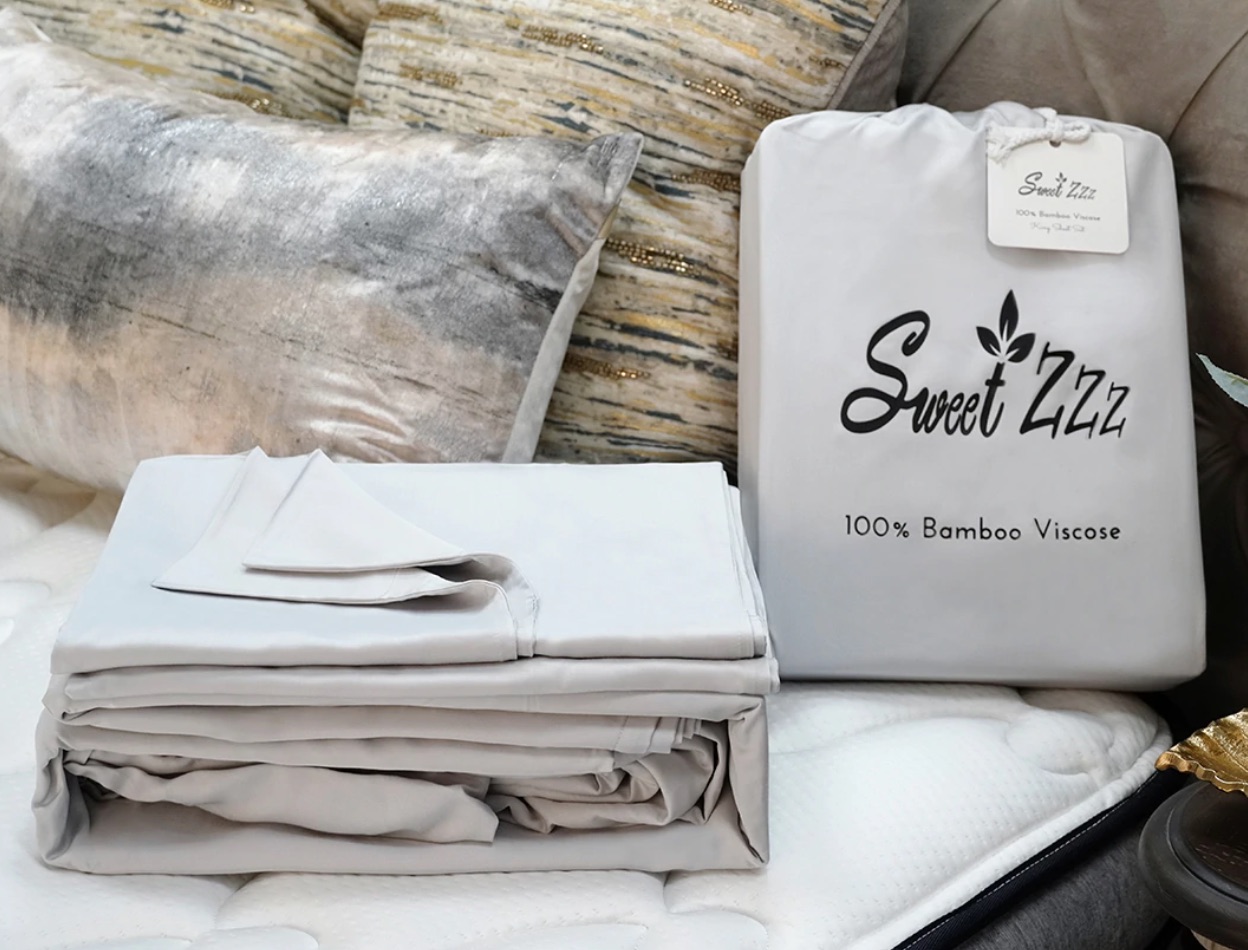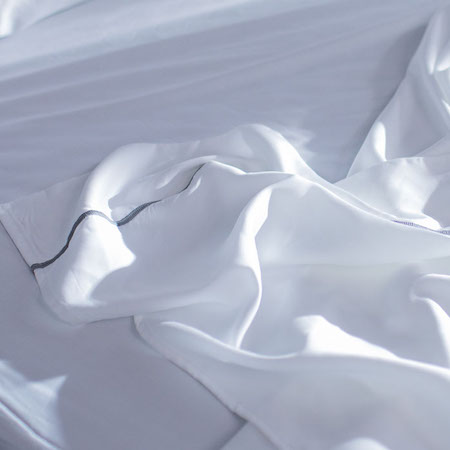Buying Guide – Shopping for the Best Bamboo Sheets
In recent years, textiles made from bamboo have become popular bedding materials. Many sleepers enjoy these materials for their durable construction, silky-soft texture, and breathability. And though fabrics made from bamboo are technically synthetics, bamboo is considered a more sustainable textile source than other natural fibers, since the plant grows quickly and thrives in different climates.
This guide to bamboo-based sheets looks at pricing, benefits for sleepers, and other important buying factors. We’ll also discuss how the fabric is produced, along with typical thread counts, weaves, and other product specifications. Read on to learn more.
From Bamboo to Bed Sheets
Many consumers share the misconception that bamboo-based fabric is made entirely of bamboo. To clarify, the fabric is derived from bamboo cellulose, a substance that forms the structure of the plant’s cellular walls; cellulose is also found in other plants, as well as vegetables.
The bamboo cellulose is extracted and treated with various chemicals, which may include sodium hydroxide (or lye) and carbon disulfide, to produce the actual fabric. For this reason, the term ‘bamboo fabric’ can be misleading – and some brands misrepresent these synthetic materials as ‘organic’ or ‘100% natural.’
Bamboo can be processed into a textile using mechanical or chemical means.
- During the mechanical process, bamboo leaves and other materials are extracted from the plant and crushed to separate the cellulose from other components. The cellulose is then spun into a fine yarn that is woven into fabric.
- During the chemical process, the cellulose is treated with chemicals that soften the cellulose fibers. The substance is then crushed and processed to produce fine threads, which are woven into fabric.
Bamboo cellulose can be used to produce several types of textiles, which include the following:
Rayon Made from Bamboo
The most common version of this material used in sheets is rayon made from bamboo. Rayon is a synthetic fabric derived from the cellulose of bamboo and other plants; to produce the rayon, cellulose is softened with lye and dissolved in carbon disulfide. The resulting material is light, breathable, and silky soft. Because rayon is a synthetic, the term ‘rayon made from bamboo’ is considered more accurate than ‘bamboo fabric.’
Viscose Made From Bamboo
The material may also be referred to as ‘viscose made from bamboo.’ Viscose and rayon are essentially synonymous terms; ‘rayon’ is most widely used in North America, while ‘viscose’ is the preferred term in Europe. For this reason, some bedding product manufacturers use ‘rayon’ and ‘viscose’ interchangeably.
Lyocell Made From Bamboo
In addition to rayon/viscose, the material known as lyocell may also be made from bamboo cellulose. Lyocell is technically a type of rayon. The manufacturing process for lyocell is very similar to standard rayon, but with one key difference: the cellulose is dissolved with an organic compound known as N-Methylmorpholine N-oxide (or NMO for short). No lye is used, which makes the material more environmentally-friendly – though it is also technically a synthetic that requires chemical agents for processing. Lyocell made from bamboo sheets are not as common as their rayon or viscose counterparts.
Other Materials
Modal is another cellulose-based fabric that may include bamboo components. However, the material is exceptionally thin, and is not as suitable for sheets. Linen made from bamboo sheets have also reached the marketplace in recent years, though these products are quite rare and expensive because processing linen from bamboo is a very labor-intensive process.
To help prevent confusion among consumers, the U.S. Federal Trade Commission (FTC) has ruled that manufacturers must label bamboo-based fabric using certain terms. If mechanically processed, the material can be called ‘mechanically processed bamboo.’ Otherwise, it must be labeled as ‘rayon’ or ‘rayon made from bamboo’; the same regulations apply to viscose made from bamboo, but the FTC does not include ‘lyocell’ in its most recent ruling. In any case, shoppers should be wary of terms like ‘bamboo fabric’ and ‘bamboo sheets’ if the manufacturer promotes these products as natural or organic.
Production differences aside, sheets made from rayon, viscose, or lyocell made from bamboo are all very similar in terms of softness, breathability, and durability. In the next section, we’ll delve into these benefits for sleepers.
Benefits of Fabric Made from Bamboo
Bamboo grass as a textile source is considered highly renewable due to its faster-than-average growth rate. The plants are normally cut at the base; once cut, they immediately begin to regrow – up to three feet in a day, in some cases. This characteristic qualifies bamboo as the world’s fastest growing plant, according to Guinness World Records.
In addition to producing fabric, bamboo can also be used as a food source; humans can consume the shoots, while other parts of the plant can serve as livestock fodder. The fibers are strong enough to create roofing, fences, and other structures, and some experts believe the plant can be used to curb deforestation. And because bamboo thrives in a wide range of ecosystems and does not require much water, many farmers consider it a more sustainable and cost-effective alternative to cotton.
Fabric made from bamboo has environmental benefits, as well. The material is considered biodegradable and will not break down into chemicals that harm the soil. This allows the fabric to be composted, rather than placed in a landfill.
Additionally, rayon, viscose, or lyocell made from bamboo sheets offer the following benefits for sleepers:
- Hypoallergenic: Very few people have allergies to sheets made of bamboo-based fabric, making them unlikely to trigger an allergic reaction.
- Cool and breathable: Rayon, viscose, and lyocell made from bamboo are all lightweight, breathable fabrics that help regulate the sleeper’s body temperature and keep them cool throughout the night. This quality can be advantageous for those who naturally sleep hot.
- Moisture-wicking: Fabric made from bamboo wicks sweat away from the sleeper’s body at double the rate of cotton, keeping them much drier. This can also help regulate their body temperature.
- Exceptionally soft: Rayon, viscose, and lyocell made from bamboo are among the softest sheet fabrics on the market. They drape nicely and sleep comfortably.
- Long-lasting: Premium sheets made of bamboo-based material usually get softer as they age, resulting in an expected product lifespan of at least four to five years. This makes them more durable on average than sheets made of other synthetic materials.
Next, let’s look at a few issues concerning the production and sale of textiles made from bamboo.
Concerns about Fabric Made from Bamboo
Although textiles made from bamboo are considered sustainable, these materials have raised a few concerns among workplace safety advocates, environmentalists, and consumer watchdogs. These concerns include the following:
- Worker safety: The production of rayon and viscose often exposes workers to carbon disulfide, a volatile compound that, when inhaled, can cause serious health problems. Employers can take measures to protect their workers from overexposure carbon disulfide, but some experts argue that current benchmarks for acceptable exposure levels are too high.
- Air and water pollution: Carbon disulfide is also an air and water pollutant. Production of bamboo-based textiles can result in both air emissions and wastewater contamination.
- Erroneous marketing claims: In addition to mislabeling bamboo-based bedding as ‘bamboo fabric’ or ‘bamboo sheets,’ some brands claim these materials are antibacterial. This is somewhat misleading; the bamboo plant is considered antibacterial, but the fabric only retains this property to a certain extent. In fact, the FTC levels fines against companies claiming their rayon-based products are antibacterial.
The Importance of Thread Count
Thread count is a significant factor in choosing sheets. Thread count is calculated by adding together the number of threads woven vertically and horizontally across one square inch of fabric.
In a well-made sheet, the higher the thread count, the softer and stronger the sheet should be. Anything greater than a thread count of 400-600 should be regarded with suspicion. That count is high enough to be comfortable but not so high that it’s potentially a scam.
Many manufacturers use multi-ply yarn and count each strand in the thread which can inflate thread count by three to four times, misleading consumers. The best sheets are made from single ply yarns.
What to Consider When Buying Sheets Made from Bamboo
When selecting a set of sheets made from bamboo-based material, shoppers should consider several factors, such as thread count, weave, and company policies related to returns and warranty coverage.
Thread Count
Most bamboo-based sheets have thread counts of roughly 300. Some sheets may advertise higher thread counts, which can indicate better quality – but not necessarily. Our advice: the 300 thread count is a good benchmark, but watch out for sets with higher thread counts that are significantly more expensive. As always, customer and owner reviews can be a valuable source of product information.
Weave
The weave refers to how the yarns are interlaced to create the fabric. Three weaves are commonly used for bamboo-based sheets:
- Percale: The percale weave is a simple one-over, one-under pattern. Bamboo-based sheets woven this way will be lighter, crisper, and stronger. Percale sheets have a distinctive feel that many liken to men’s dress shirts..
- Sateen: This weave can be two-, three- or four-over and one-under in both directions. Bamboo-based sheets with the sateen weave are silkier and have a distinctive sheen. They also tend to be thicker (and less breathable) than percale sheets.
- Twill: The twill weave is over and under, but follows an offset pattern that creates diagonal ribbing. Bamboo-based sheets with the twill weave are exceptionally durable and drapey.
Cleaning and Maintenance
Bamboo-based sheets need special care; always read the manufacturer’s instructions before cleaning. Most brands discourage owners from cleaning their sheets with peroxide or alpha hydroxy, both of which can discolor the fabric. Bleach should also be avoided, even if the sheets are white.
Fabric softener and dryer sheets are not recommended nor needed, since high-quality sheets made of bamboo-based material are already quite soft. Chemicals can break down the bamboo cellulose fibers and shorten the lifespan of the sheets. Our recommendation: separate the sheets from other items and wash in cold water every one to two weeks.
Mild liquid detergent (not powder) is preferable. High heat damages the fibers, so line drying is considered the best option for these sheets. If this creates too much hassle, owners may tumble dry the sheets on low and remove them once they are completely dry. Bamboo-based sheets may wrinkle; iron on a low setting only.
Neutral Colors
Because bamboo-based sheets have excellent longevity, owners should carefully consider their color options. Dark, rich colors may fade even though the fabric stays in good condition.
Since many people periodically change their duvets, comforters, and other bedding components, we recommend neutral colors to complement evolving décor. Neutral colors also help create a calming sleep environment; in contrast, vivid or visually striking colors can stimulate the brain and cause sleep onset issues.
Organic vs. Non-organic
Generally speaking, organic textiles are grown, cultivated, and produced without harsh pesticides or chemicals. Many brands tout their sheets and other textile-based products as organic. However, the label is somewhat meaningless without official certification from the Global Organic Textile Standard (GOTS); this organization is widely recognized as the foremost authority for this topic.
GOTS certification mandates the following:
- The textile must contain at least 70% organic fibers
- All dyes and other chemical inputs must meet certain criteria related to toxicology and environmental impact
- If production involves wet-processing units, then the facility must have a functional wastewater treatment plant.
According to the GOTS, almost all bamboo-based textiles are not considered organic or natural, since the bamboo cellulose is melted and regenerated using chemical or mechanical means. However, if the cellulose is extracted from organically grown bamboo plants, then the label may say ‘Made from Organic Materials.’
The bottom line: if bamboo-based sheets are truly organic, then the brand will likely display its GOTS certification on the product page and elsewhere on the website. Otherwise, consumers should be wary of such claims.
Warranty, Sleep Trial, & Return Policy
Sheet buyers should understand the differences between a product’s return policy, sleep trial, and warranty, as all three are distinct from each other.
- A return policy indicates if and how customers may return merchandise after purchasing. Typically, brands that sell sheet sets allow customers to return unused and unopened items within 30 to 90 days and receive a full product refund (minus shipping fees if applicable). Some brands cover return shipping costs, while others leave these up to the customer.
- A sleep trial, as the name implies, allows customers to test out sheets for a certain length of time – usually 120 nights or less. If the customer is dissatisfied with the sheets before the trial expires, then they can return them for a full refund. Sleep trials are somewhat rare for sheets, since they come into contact with the sleeper’s skin and cannot be reused or resold. Sleep trials are usually listed along with the brand’s return policy, so be sure to read the fine print before buying.
- A warranty is essentially an agreement between the manufacturer and the customer. If the sheets prove defective due to material flaws, unraveled seams, or other issues, then the company promises to replace the sheets with a new set or refund them in full. Other issues – such as damage during laundering, normal discoloration, or tearing – are usually not covered under warranty. Most sheet warranties cover the product for five years or less, though a large number of brands do not offer any sort of warranty coverage.






